This document is intended to aid registrars who are just starting out
with EPP. Whether you are new to the domain name registrar scene, or if
you are growing your domain name registration portfolio with an EPP registry
(e.g. .NAME, .INFO, .PRO, .BIZ, etc...), this document should give you
the necessary help to get started. For those registrars who already have
experience with RRP (e.g. VeriSign's COM/NET/ORG registry), this document
contains helpful hints and EPP/RRP comparisons.
There are two majors aspects to EPP: objects and actions. Objects are
entities stored in the EPP registry, such as domains, contacts and hosts
(aka "nameservers"). Actions affect changes to the registry
and the objects it contains (eg. check, create, update, delete...). EPP
registries and registrars communicate via messages in XML format. XML
conveniently organizes data in requests and responses into logical groups
and hierarchies. Because of the way the protocol is defined, it is transport
independant. This means that a registry may offer any number of transport
layers to carry the EPP message (eg. plain TCP, TCP+TLS, SMTP, BEEP, ...).
EPP is also easily extensible. Registries, depending their own or their
domain's business needs, may define additional object type or actions,
or even additional payload data for existing messages.
In the arena of domain names, the most obvious is registering domains.
As explained earlier, EPP defines three main object types: domains, contacts
and hosts. It also defines a core set of actions (some of which are not
applicable to all object types): check, info, create, update, delete,
transfer and renew.
For those of you who come from an RRP background, this chart draws a
parallel between RRP and EPP:
Outside of the realm of objects, EPP defines the following requests:
login, logout, hello, and poll. Login and logout should be pretty self-explanatory:
they allow a registrar to establish a persistent connection to an EPP
registry. The "hello" request allows a registrar to solicit
a greeting from the registry (the greeting will be explained more a little
later). The poll action is the mechanism by which a registrar can retrieve
notifications from the registry, such as object transfer-away notifications.
The greeting is used by an EPP registry to let the registrar know which
services and options it offers. In a connection-oriented session, the
greeting is spontaneously sent by the registry when the registrar connects.
In a connectionless session (e.g. SMTP), the registrar must expressly
ask for a greeting by sending the "hello" command. This command
can also be used in connection-oriented sessions, although the services
offered since the greeting was sent should not have changed.
EPP allows for two types of sessions: persistent and stateless. In a
persistent session, the registrar establishes a connection (e.g. over
a TCP socket) and issues the login command before any other request. The
login contains the registrar's client ID, password (and optionally a new
password), preferred language, preferred protocol version and a list of
services which the registrar wishes to use. An EPP registry could reject
a login from a registrar for a number of reasons. Those include:
Note that providing a new password in a login is the only way the registrar
can change its password through EPP.
Here is an example of the login command where the registrar wishes to
use domain, contact and host services:
Notice that the "creds" (i.e. credentials) are contained outside
of the login tag. This is what facilitates stateless sessions. Once a
registrar is logged in, the creds must not be present in any further commands,
including the logout. In a stateless session, the registrar must specify
the creds at each command. If a registrar is using a connection-oriented
transport (e.g. a TCP socket), it is recommended that a persistent session
be used. This is usually more efficient because the server doesn't have
to validate the client ID and password at each command. Some registrars
might only allow persistent sessions over connection-oriented transports.
Note that it is more efficient to maintain the same connection and session
for as long as possible. As many registries require secure, encrypted
communications, the "handshake" portion of the connection can
be resource intensive. Repeating the steps of connecting, logging in,
sending a single command, logging out, and disconnecting would be very
costly to the registrar and the registry. If the registrar is using a
connectionless transport (e.g. SMTP), then a stateless session must be
used and the login and logout commands are not valid and will be rejected.
In every EPP command, there are two other optional command elements:
unspec and clTRID. The latter is pretty simple. It is a client transaction
identifier holder. The registrar may use it to track requests for logging
or auditing. The clTRID, if supplied, is returned along with the svTRID
(server transaction identifier) in the response to an EPP command. In
the response, they are both wrapped in the trID tag. It is highly recommended
that the registrar use the clTRID for every "transform" action
(i.e. create, delete, update, transfer, renew).
The registrar may optionally use the clTRID in query actions, but because
these actions don't normally incur a charge to the registrar, transaction
tracing and tracking is not as critical.
The unspec tag is a little more complex. It can be present in both EPP
requests and responses. It is a placeholder for registry-specific extensions
to EPP. For instance, the .info registry, during its Sunrise Registration
Period, was using the unspec tag to hold the domain trademark data in
create, info and update commands. The registrar should contact their registry
operator to determine if there are any unspec extensions that must be
used in interactions with the registry.
Now, let's look at few typical tasks that a registrar would want to perform.
We'll describe the commands and the required data for those commands.
Domain Registration: Domain Create
Being at the core of a domain registrar's functionality, we'll start
with this one. Actually, we'll start with a step a registrar should
perform before issuing a domain create action. To not waste precious
time of the registrant, there is a command to allow the registrar to
check if a domain name is available before actually submitting a registration
for it. EPP offers this in the domain check action. This command actually
allows a list of domains to be checked. The command is as follows:
(A note for these XML examples: the namespace
specifications for these commands might vary depending on the version
of EPP the registry is using. Please see the section at the end of document
regarding EPP versions.)
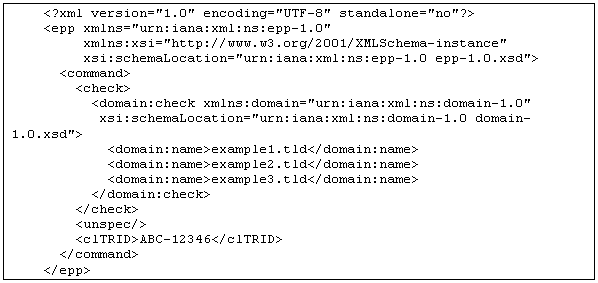
The response will contain the same list of domains (though not necessarily
in the same order) with indicators to say whether the registry knows
of this domain or not.
Here is a typical response:
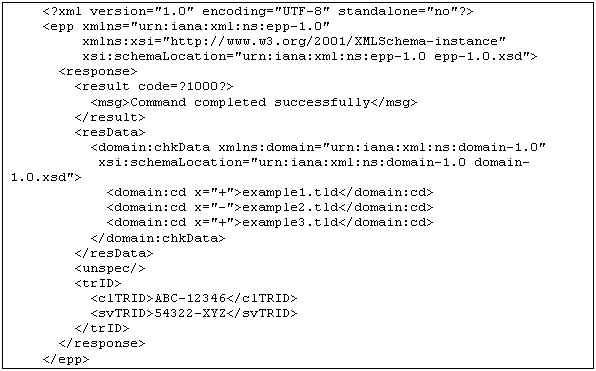
The "+" sign indicates that the domain exists in the registry.
The "-" sign, then logically, means that the domain does not
exist in the registry and is available for registration.
If a domain is available for registration, then the registrar can continue
with the domain create command. With all of the optional data defined
by EPP, this command is one of the simplest. All it requires is the
name of the domain to create and the authorization information for the
new domain. Authorization Information (or simply "auth info")
is a passphrase a registrar asks of its registrant when creating a domain
or a contact. This passphrase is used by the registrant to authorize
a transfer of the object to another registrar. A reminder for RRP graduates,
this command equates to "add domain".
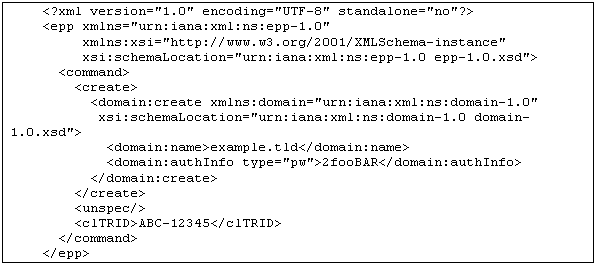
Now, unfortunately, sometimes this command might not always be this
simple. First, without specifying a period of activity for the domain,
the registry will apply its default, which might or might not be 1 year.
It's always best to specify a period so that there's no ambiguity and
no surprise if the default value is not what was expected.
Second, some registries might impose that some of the optional data
is required. The .info registry, for example, requires 2 nameservers,
a registrant contact and at least three other contacts, one for each
type (admin, billing, and tech). So it's very likely that you might
have to specify other commands before the domain create. Let's move
on for the moment to the creation of other EPP objects.
Back to top
Contact Creation
EPP is designed for thick registry operators who require contact information
for centralized WHOIS services. Therefore, an EPP registrar is allowed
to create contact objects in the registry and associate them to domains.
Contact object maintenance is the most complicated part of EPP. Once
you've mastered it, the rest is easy.
To create a contact, a registrar must collect the following information
from the registrant (optional items are marked with a '*'): name, organization*,
postal address (street (up to three), city, state/province*, postal
code* and country), voice phone number*, fax phone number* and email
address. Now, because of the demands of a multilingual world, the postal
address of a contact can be specified in UTF-8 encoding (note that some
registries might not support this). EPP requires that there be at least
an ASCII 7-bit version provided. This is for more legacy uses, such
as traditional WHOIS.
Ok, so, the contact create command goes something like this:

Now, watch out. Depending on the version of EPP which the registry
is using, you may or may not have to specify a contact ID on contact
creation. At the time of this writing, the .INFO registry is/was using
a version of EPP where you don't specify the contact ID. The response
to the contact creation will return the newly-created Repository Object
Identifier. This "ROID" will identify the contact object in
associations with domain objects. In newer versions of the protocol,
the registrar-specified contact id is used.
The contact create example above only shows the including of the 7-bit
ASCII address in the "contact:ascii" tag. This information
is mandatory (although some elements in the address are optional). There
is an additional and optional address tag called "contact:i15d".
The "i15d" is short for "internationalized" (starts
with i ends with d with 15 characters between them. Clever, huh?). This
tag can contain the contact's address with UTF-8 characters.
The sp, pc and cc tags in the address contain the state/province, postal
code and country code, respectively. The country code must be specified
using the standard ISO country code listing. And, yes, it currently
does not include "UK" (among other countries). "GB"
should be used in its place.
Once the contact is created, the object identifier can be used in associations
with domain objects. Domains can have a single registrant contact. hey
can also have any number of administrative, billing and technical contacts.
Let's put this aside for a moment and take a look at nameserver creation.
Back to top
Host (aka "Nameserver")
Creation
Nameserver creation is pretty simple. There are two types of nameservers:
those that belong to the TLD(s) that are authoritative to the registry
and those that don't (i.e. "foreign nameservers"). The difference
between the two is the nameservers that are outside of the authoritative
TLD(s) of the registry don't get IPs in the registry. The idea is that
only the authoritative registry for the nameserver's domain should know
the nameserver's IP address(es). The native nameservers can have up
to 13 addresses (a limit imposed by many, if not most, registries).
IP addresses in EPP come in two forms: IPv4 and IPv6. Note that some
registries might not allow IPv6. Also note that the EPP registry may
prohibit certain IP ranges from being used. Check the EPP Host spec
or with your registrar for those ranges, but those are usually the ones
that haven't been allocated for public use by IANA.
The host create command:
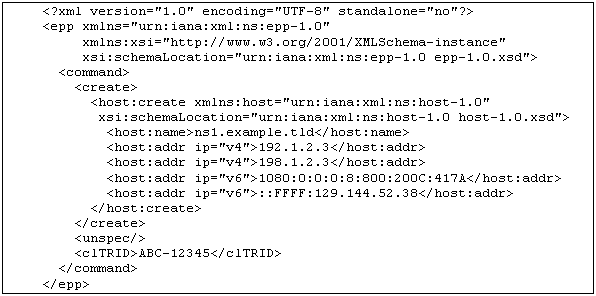
Notice that you can mix and match IP address types for a single host.
That's it. Pretty simple, huh?
Back to top
Domain Create (con't)
Now, let's get back to the domain creation. Here it is with contacts,
nameservers and the period specified:
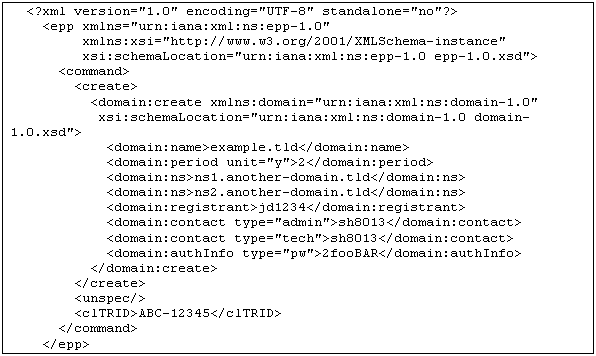
Notice that the same contact ID is being used for both the admin and
tech contact types. That contact ID could have also been used for the
registrant. Also take notice that the nameservers for this new domain
are not using the same domain name. EPP registries will not implicitly
create nameservers in the same domain namespace upon creation of the
domain. That's because native nameserver require at least 1 IP address,
which can't be specified in the domain create command. Note that the
order of the nameserver is not significant in DNS resolution of the
domain. This order is not necessarily preserved in the "domain
info" response.
Back to top
Querying existing objects: the INFO
command
Once an object is in the EPP registry, a registrar may retrieve information
regarding the object. This is achieved through the "info"
command. The info request for any of the currently known EPP objects
is very simple. All that is required is the object identifier. For domains
and nameservers, this is the fully qualified name of the object (i.e.
the domain's name or the nameserver's name). For contacts, this is either
the contact's ROID that was returned by the creation of the object or
the contact id that was provided by the registrar in the contact create
request. This depends on the version of EPP that the registry is using.
For RRP users, "info" is synonymous with the "status"
command. The major difference is that, in RRP, only the current sponsoring
registrar is permitted to use the status command on a domain or nameserver.
In EPP, all registrars are permitted to use the info command for all
objects. Registry policy defines what is viewable by registrars using
info. Typically, only the current sponsoring registrar is returned the
object's auth info in the response from the server. This protects the
object from malicious transfer requests, since the auth info is required
by the registrar requesting the transfer.
To provide a typical example of usage, here is a domain info request.
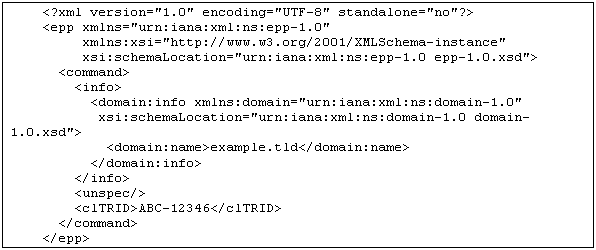
The server's response to this request could be something like this:
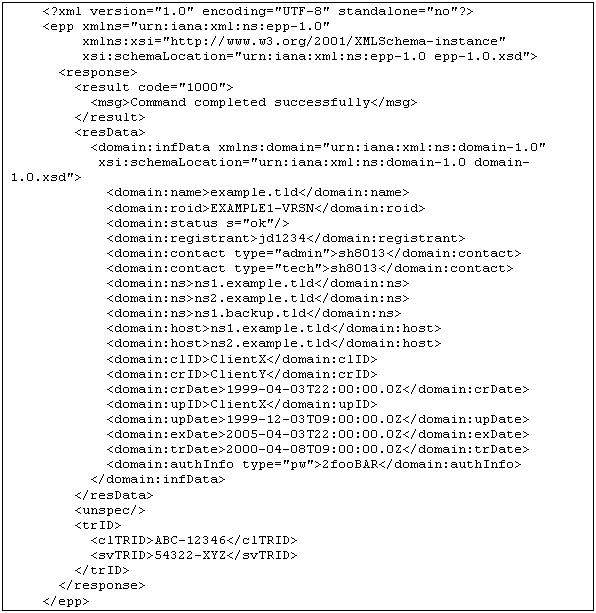
The example response show many of the typical fields in any info response.
The common fields are as follows:
- roid -- the ROID of the object in the
registry
- status -- the current status of the object
(there can be multiple); there may also be optional descriptive text
for each status
- clID -- the ID of the object's current
sponsoring registrar
- crID -- the ID of the registrar that created
the object
- crDate -- the UTC date of the object's
creation
- upID -- the ID of the registrar that last
updated the object (absent if the object has never been updated)
- upDate -- the UTC date when the object
was last updated (absent if the object has never been updated)
- trDate -- the UTC date marking the last
successful transfer of the object (absent if the object has never
been transferred; for hosts, this is the same value as the parent
domain in the registry)
- authInfo -- the auth info field for the
object (absent if the querying registrar is not the sponsoring registrar;
not applicable to host objects)
For domains, the following may also be there:
- name -- the fully qualified name of the
domain
- registrant -- the domain's contact that
is acting as the registrant
- contact -- the domain's contacts (admin,
tech or billing); there can be any number of these
- ns -- the list of hosts serving as nameservers
for resolution of the domain
- host -- the list of hosts that exist in
the same domain name space as the queried domain
- exDate -- the UTC expiry date of the domain;
the domain renew or transfer actions may be used to extend the life
of a domain beyond its original creation period; note that an EPP
registry may impose a maximum lifetime for domain objects (like, say,
10 years).
For hosts, the following info response fields may be present:
- name -- the fully qualified name of the
host
- addr -- the list of IP addresses assigned
to the host
- linked -- boolean value to indicate if
this host is linked to a domain
For contacts, the following fields may be present:
- id -- the contact's id (only present in
recent versions of EPP)
- ascii -- the 7-bit ASCII version of the
postal address*
- i15d -- the UTF-8 version of the postal
address*
- linked -- boolean value to indicate if
this contact is linked to a domain
* Both of the address types contain the name, org, addr, voice, fax,
and email elements. The addr element further contains the street, city,
sp, pc, and cc sub-elements. "sp", "pc" and "cc"
being state/province, postal code, and country code, respectively.
Back to top
Object Updates
With all three types of objects in the registry, we can now move on
to the update command.
Generally, the update command contains three elements: items to add,
items to remove and items to change. The items in each of these elements
depend on the type of object being updated. For example, you may add
or remove contacts from a domain, or change the fax number of a contact.
Please note that whatever data elements where mandatory on object creation
are still mandatory on update. For example, if a domain requires at
least one tech contact and you wish to change that contact, you'll have
add a new tech contact and remove the old one. EPP allows you to perform
those two actions in a single domain update command.
Another note: a registrar may only update objects for which it is the
current sponsoring registrar.
Domain Update
The updatable values for domain objects are the registrant, the contact
list, the nameserver list, the status list and the auth info. The registrant
value is changeable (i.e. it "cannot" be removed or added,
since it is not a list). In the update command, simply specify a new
value and the server will replace the old one. If the registrant value
is optional in the registry with which you are communicating, you may
specify an empty tag (i.e. "<domain:registrant/>" or
"<domain:registrant></domain:registrant>") and
the server will "remove" the existing value. With the RTKs
available today from Sourceforge, leaving the registrant value null
or NULL will have it omitted from the XML request to signify to the
server that no change is requested to the registrant value. Specifying
an empty string (i.e. "") will force the RTK to send an empty
tag to the server. The registrant must be a valid contact in the registry
in order for the update to be successful.
Since both the contact and nameserver parameters are lists, values
may be added or removed from them. In the update command, simply specify
a valid contact or nameserver identifier to add a new value to the lists.
To remove an existing contact or nameserver from the domain's current
associations, specify that contact or nameserver in the "remove"
list. When removing a contact, the proper contact type must be specified
in the remove list. Since a single contact can cast in multiple roles
with the domain, the registry needs to know specifically which contact
to remove.
The status values are also contained in a list and can be added or
removed. The registrar is only permitted to add or remove stati that
start with "client" (eg. "clientHold"). Depending
on the version of EPP in use at the registry, the list of available
stati might vary (in the Java and the C++ RTK's that use the IDLs defined
by a group of registry operators, the list of stati is available in
the epp_DomainStatusType class or enum). When adding new stati to a
domain, the registrar is permitted to specify a short text message to
accompany the status. When removing stati, the descriptive text should
not be included. Also if a status is already applied to a domain, the
status cannot be applied again. If the registrar wishes to change the
status descriptive text, then the status must be removed and then re-added
to the domain. This should be possible to perform in a single update
command.
The auth info is another changeable value. As it is required for domain
objects, it cannot be set to a blank value, in fact EPP imposes minimum
and maximum length values on the auth info.
Here is an example of a domain update command:
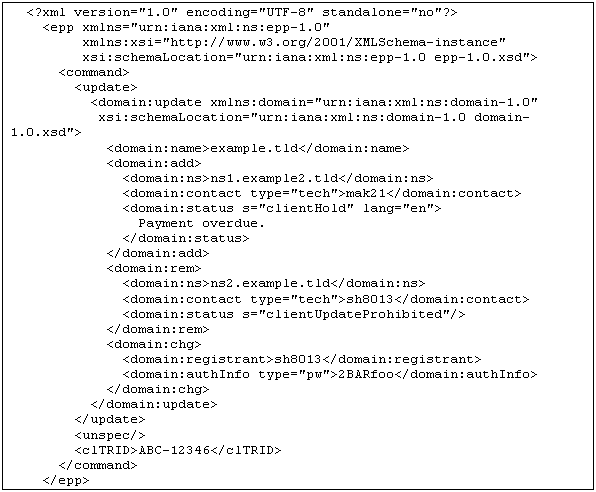
Contact Update
The contact update action is not as equally balanced as the domain
update. The bulk of the updateable data is in the "change"
portion. The only values that can be added or removed are contact stati.
The format for the status values is the same as in the domain update
command (i.e. only client-usable status values, plus an optional descriptive
text).
The changeable data for a contact is the address. Both of them actually,
since there's an ASCII version and an I15D version.
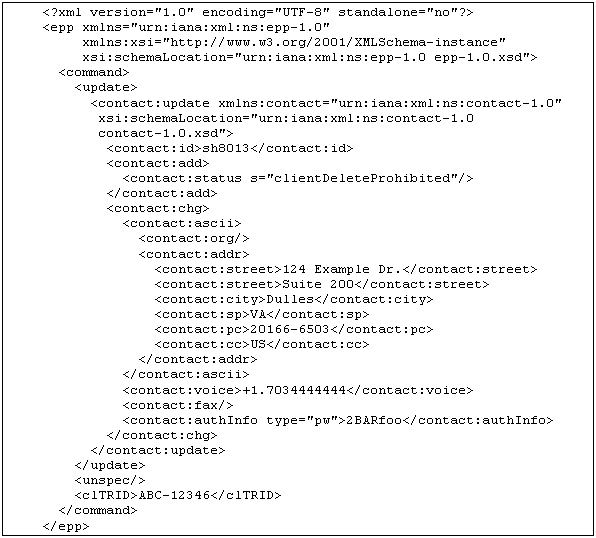
Host Update
This is the simplest of the update commands. For a host, IP addresses
and stati may be added or removed. Also, the host's name may be changed.
The status additions and removals are the same as with domains and contacts.
The IP addresses follow the same format as in the host create (i.e.
the actual IP address and address type).
The host update command allows for the full host name to be changed.
For instance, you may rename "ns1.domain.tld" to "ns2.domain.tld".
This should usually present no problem, so long as the former does not
already exist. You may also rename the domain in which the host resides.
For example, changing "ns1.domain1.tld" to "ns1.domain2.tld".
Of course, to do this, "domain2.tld" must exist in the registry.
And if "domain2.tld" is outside of the TLD bounds of the registry,
the restriction of no IP addresses comes into play.
Here a sample host update command:
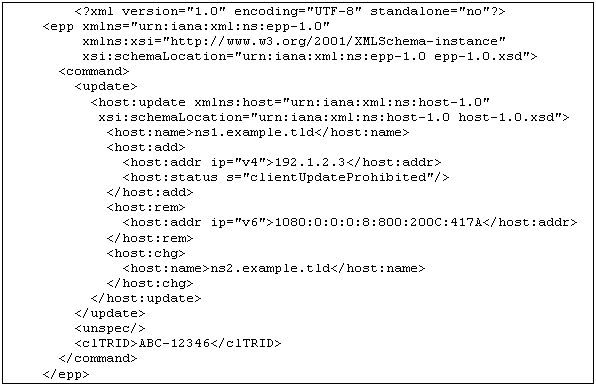
Back to top
Object Deletions
Just as you can create objects in a registry, you can delete them too.
Of course, you must be the current sponsoring registrar in order to
successfully delete an object. There also might be further restrictions
on some objects. For instance, objects associated to other objects cannot
be deleted until the association is removed. An example of this would
be a contact being associated with a domain. The contact cannot be deleted
until its associate with the domain is removed (via the domain update
command). Note though that the domain can be delete without disassociated
it from the contacts and hosts. The delete (once the object truly disappears)
automatically frees associated objects.
All delete commands follow the sample simple pattern. All that is required
is the object's identifier (domain name, host name or contact ID or
ROID). Here is a delete command for a host object:

Note that some registries may impose time restrictions on object deletions,
especially in regard to domains. It is common for a registry to allow
a "hard" delete within 5 days of domain creation, and to provide
a "soft" delete after the first 5 days. A "hard"
delete is when the domain is truly removed from the registry upon successful
delete. A "soft" delete adds the "pendingDelete"
status to the domain. A registry-defined period of time later (often
5 days) the domain will truly disappear. This is to allow accidental
deletes to be undone, though that usually requires a call to the registry
operator support staff. Check with the registry with which you are dealing
to determine the policies applicable to you.
Back to top
Beyond Basic Operations in EPP
Outside the basic check, info, create, update and delete, there's a
few more operations available to some objects.
Domain Renewals
When a domain is created, a "period" is usually specified
by the registrar (or defaulted by the registry if it's absent from the
command). The period, in years or in months, defines the lifetime of
the domain object. After that period passes, the domain expires. Although,
things may not be that simple. We'll deal with registry policies in
a moment. First, let's take a look at extending the validity period
of a domain.
(Note that none of this section applies to Contact
or Host objects. Those objects never expire, although when and if a
domain expires, the child hosts, if any, will likely be locked, which
could affect the resolution of other domains they serve.)
Anytime before a domain expires, it may be renewed by the sponsoring
registrar. The expiry date of a domain can be found through the domain
info command. The original expiry date is also returned on domain creation.
In the domain renew command, three values can be provided: the domain
name (required), the current expiry date (year, month and day -- required)
and the renewal period (optional). The current expiry is required to
provide idempotency to the renew command. This means that the same renew
command cannot be processed multiple times. This protects the registrar
against such things as "double clicks" from the registrant,
incomplete renew requests because of a broken connection to the registry
or, otherwise, bugs in registrar code. To issue a subsequent renewal
on the same domain, the new expiry date must be used (it is provided
in the renew response). The period allows the registrar to specify a
value other than the registry's default renewal period (which is often
a year). According to EPP, the renewal period can be anywhere from 0
to 99 years or months. Registries often narrow this down a little ('cause
0 years is just silly). Typically, a registry limits the expiration
date of a domain to be no more than 10 years in the future.
Now, what happens when a domain expires? Well, this depends heavily
on registry policy. EPP does not define any action that the registry
must take when an object expires. Registries tend to treat domains similar
to magazine subscriptions. Registrant retention is important because
it generates revenue. So registries will try to encourage registrants
(through their registrars) to renew their domains. This is also good
for registrars because it means revenue to them as well. Typical actions
you might see a registry take are auto-renewal of domains which have
expired. Normally the registrar will have a grace period during which
the domain can be deleted with no charge. Some registries might simply
extend the life of the domain for a short period of time to give late
registrants time to decide on renewal, and attempt to delete the domain
if there is no action taken by the registrar. The registrar should be
aware that during these "grace" periods, the domains might
go into a locked state where the name is no longer resolvable in DNS.
If there are hosts in that domain that are serving other domains, then
those domains might become unresovable as well. Between registry-auto-renewals
and notifications to registrants, domain expiry and renewal can be a
complex matter. Be sure to contact your registry operator to make sure
you know which policies are in place.
Those with experience with RRP and VeriSign's COM/NET/ORG registry
will know that domain expiry and renewals can be tricky. The registrar's
system should be proactive in dealing with domain expirations using,
perhaps, advance notifications to the registrant. Some registrants might
just never respond, so the registrar should be able to delete the domain
before there is a charge for the auto-renewal.
Back to top
Object Transfers
In EPP, both domain and contact objects may transferred between registrars.
This changes the sponsorship of the object in the registry from the
losing to the gaining registrar. The key to object transfers is the
authorization information for each object. For those coming from RRP,
the auth info is what prevents registrars from "stealing"
domains (and now contacts) from other registrars. Only the current sponsoring
registrar, and, consequently, the registrant, have access to the auth
info (via the "info" command). The registrant gives this string
to the registrar to which they wish to transfer. This allows the requesting
(or "gaining") registrar to issue a transfer for an object
and to query its current transfer status. Once an object is successfully
transferred, the gaining registrar should recommend the registrant change
their auth info for the transferred object so that the losing registrar
cannot reclaim the object without the registrant's permission in a subsequent
transfer.
The transfer command in EPP has several operations: query, request,
approve, reject and cancel. The requesting registrar should perform
a transfer query first to ensure that the auth info is valid. Here is
the transfer query command for a domain object:
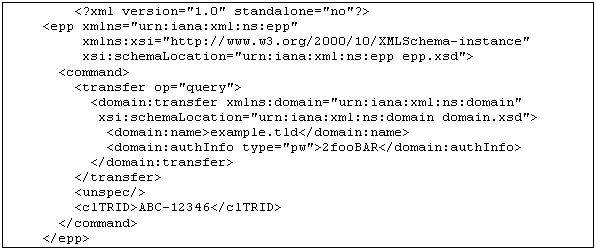
The response would look something like this:
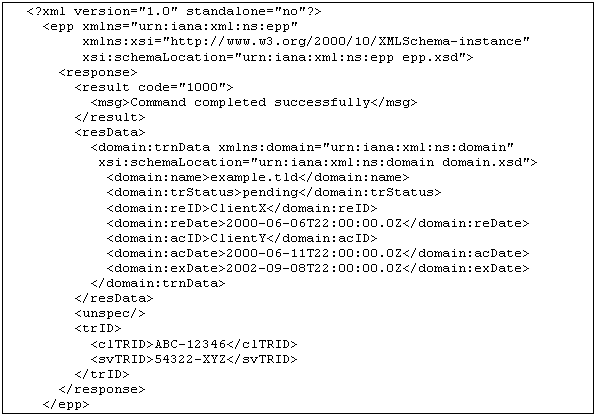
The response contains the information of the current or most recent
transfer issued on the queried object. If the object has never been
transferred, then the EPP registry will return an error code. If the
trStatus is "pending" then a transfer is currently being executed
on the object. Other stati for transfers are: approved, cancelled, rejected,
autoApproved, and autoCancelled. Those all indicate that the last transfer
operation is complete and another may be issued. The "reID"
and "reDate" are the client id of the requesting registrar,
and the date of the request, respectively. The "acID" is the
ID of the "losing" registrar for that transfer request. The
"acDate" can have two meanings. If the transfer is pending,
then the acDate is the date by which the losing registrar can take action
on the transfer (i.e. approve or reject it). If the transfer is complete,
then this is the date when the transfer was finalized (either by the
losing registrar approving or rejecting it, the gaining registrar canceling
it or by the EPP registry taking automatic action). The proposed expiry
date from transferring domains is in "exDate". This member
will not be present for contact transfers since contacts never expire.
Maybe this would be a good time to talk about how transfers work in
EPP. RRP users will find most of this familiar.
- A registrant goes to a new registrar with their domain. Maybe the
new registrar has a better package deal with better prices?
- The registrant provides the auth info to the registrar.
- The registrar issues a transfer request, with an optional renewal
period. If the auth info provided was invalid, then the transfer request
will fail. (A transfer "query" could have told the registrar
this, but why perform in two requests to the registry what you can
accomplish with a single request?)
- If the request was successful, the current sponsoring registrar
receives notification that a domain of theirs is being transfered
away.
- Depending on registry policy, the losing registrar might have a
couple of days to proactively approve or reject the transfer. The
requesting registrar also has a chance to cancel the transfer request
during this time.
- If the losing registrar takes no action, the registry will likely
automatically approve or reject the transfer depending on their policies.
Most will usually auto-approve transfers.
- The gaining registrar should receive notification of the results
of the transfer. If the transfer is successful, the gaining registrar
will be charged for the renewal period of the domain. If none was
specified in the request, the registry usually assigns a default (often
1 year).
So, here's the transfer request for a domain:

Notice that the requesting registrar is asking for a 2 year renewal.
The response to the transfer should be identical to the transfer query
request. In fact, responses to all types of transfer operations have
the same format.
If the losing registrar wishes to take action on a transfer, the following
command may be used:

Only the domain name and auth info are required in the request from
the losing registrar.
As mentioned in the steps above, the current sponsoring registrar will
receive notification of a pending transfer. This will likely be through
the poll mechanism, which is described below. The optional data that
will appear in the poll response will be the results in a transfer query.
Registrar Session Management
As a registrar, it isn't simply enough to be able to manage objects.
As a registry client, you should be able to manage your sessions as
well. This includes such aspects as keeping a persistent connection
alive during period of little or no activity and dealing with notifications
from the registry. Luckily, in EPP, those two can be accomplished with
a single command: Poll.
Polling
As stated earlier, polling accomplishes two goals: keeping a session
alive and retrieving notifications from the registry. It's great for
keeping a persistent connection alive because of its harmless nature.
Its default form is a query. Registries that use EPP maintain a queue
of messages and notifications for each registrar. These messages will
typically be regarding object transfers, but may also include such things
as low balance notifications, pending domain expiry, auto-renewal notifications,
and so on. Unfortunately, with exception of a plain text message, EPP
doesn't define the data that can be returned in a poll response. This
is up to registry policy and EPP extensions.
The way that poll works is such: A registrar may poll its queue in
the registry. Poll comes in two operations: Query and Acknowledge. As
a registry processes changes to objects, notifications may be added
to the end the registrar's queue. The registrar may use poll-query to
retrieve the message sitting at the front of the queue. If the queue
is empty the response code and text will say that. If there is a notification,
there will be a message id, message text and optional data in the response.
The registrar must then issue a "poll/ack" to dequeue the
message. The notification's id must be supplied in the poll/ack. The
registrar repeats this process until the queue is empty.
Most registries will terminate a persistent connection if there is
no activity on the connection for a given period of time (contact your
registry to find out that period). For a single connection, the registrar
should keep track of the last communication time and poll the registry
when the elapsed time is just under the registry timeout value. If you
poll too often, you might be needlessly taxing the registry's system
and you might be wasting time when your system processor could be doing
something more productive.
RRP users can equate poll with the 'describe' command for keeping connections
alive. There is no equivalent of registry message queues in RRP.
EPP Response Codes
EPP organizes its error codes into groups. There are two major headings:
success and failure. The former has response codes in 1000s range. The
latter in the 2000s range. Within these ranges the response codes are
further divided. The group is as follows:
x0xx -- Protocol syntax
x1xx -- Server policy and implementation
rules
x2xx -- Security and authorization
x3xx -- Data management
x4xx -- Server and internal errors
x5xx -- Connection management
Every response in EPP contains a response and a corresponding text.
Along with that is a language indicator. The default language is "en".
Registries have the option of providing the message texts in the language
that was indicated in the "creds" (for example, at login time).
1000 - Command completed successfully
Everything's a-okay! The command was successful. If a object was
created, then an "info" should now be possible on that object.
1300 - Command completed successfully; no messages
Standard Poll response when there are no message waiting in the server
for your registrar account.
1301 - <variable notification message from poll response>
Poll response where a meaning full message is provided. Depending
on the message, there might also be additional data included in the
Poll response (e.g. to identify the domain being transferred).
1500 - Command completed successfully; ending session
The standard response to a successful logout.
2000 - Unknown command
The registrar has sent the registry an unknown command (i.e. none
of login, logout, hello, poll, check, info, create, update, delete,
transfer, or renew).
2001 - Command syntax error
Generic error message when the server doesn't understand what you've
sent. Maybe the XML is invalid. Try passing it through a validator.
Perhaps you are including parameters that don't belong to the command
in question.
2002 - Command use error
The registrar is asking the registry to do something that is not
valid in the current context, like a logout before a login. Or a domain
create (without creds) outside of a session in a connection-based
transport (e.g. TCP).
2003 - Required parameter missing
A domain create without the domain name. Contact update without any
"add", "rem" and "chg" tags. Something
was missing in the request that the server requires to execute the
command.
2004 - Parameter value range error
This error code can means a few things. Most common causes are parameters
that are too long (domain names, auth info, contact name, etc...).
It could also be used for numeric parameters that are either too large
or too small for the range defined by the registry (e.g. domain period).
Data should be verified as much as possible by the registrar before
sending to the registry. Return to the registrant and get him or her
to correct the input data and resubmit.
2005 - Parameter value syntax error
The format of the parameter is not correct. This usually does not
include length checking, which should be covered by error code 2004.
A typical cause of this error code is in contact creates where the
voice or fax phone number don't match the E.164 format for international
telephone numbers. A (North American) example of this would be "+1.4165550101".
The regular expression for this in the XML schemas is "(\+[0-9]{1,3}\.[0-9]{1,12})?".
The number between the "+" and "." signs is the
country's dialing code.
2100 - Unimplemented protocol version
The registrar has attempted a login using a version of the protocol
that is not supported by the registry. The registrar is free to attempt
further logins with different version numbers using the same connection.
2101 - Unimplemented command
This error will be returned if an action being attempted on an object
is not implemented by either the protocol or the server. For example,
host renew. Further attempts of this command will fail.
2102 - Unimplemented option
This error code would be returned if the registrar is attempting
to issue a sessionless command (with creds) when the server has not
implemented that feature. Essentially, 2102 will appear if the registrar
is attempting a valid command with options that are not supported
by the registry.
2103 - Unimplemented extension
An extension that the registrar is attempting to use (maybe from
another registry) is not supported by this registry. Removing the
extension from the XML request and retry the command.
2104 - Billing failure
This could mean a few things. The most command cause is that the
registrar is out of funds in the registry. Further retries of the
command will fail until the registrar's account balance is increased.
Some registries may implement a "low threshold" notification
system so that registrars can be warned when their balance runs dangerously
low. If the registrar's balance is not the problem, then the server
may be experiencing internal problems. The registry operator should
be contacted in this case to report the problem.
2105 - Object is not eligible for renewal
2106 - Object is not eligible for transfer
A typical case for this error code and message would be trying to
transfer an object shortly after it's been created. In the case of
domain registries, some have defined a period of time after a domain
has been created when transfers are not permitted.
2200 - Authentication error
In a session-based connection, this error code will be returned on
a login if the client ID or password are incorrect. This can also
be returned by any command in a sessionless situation where the command
creds are invalid.
2201 - Authorization error
This response would normally occur when trying to perform an update,
delete or renew an object that is not sponsored by the acting registrar.
2202 - Invalid authorization information
This response occurs if the auth info in the transfer command (query
or request) is invalid. Note that the auth info is not required for
the approve, reject and cancel transfer operations. The registrar
should confirm the correctness of the auth info with the registrant
before continuing.
2300 - Object pending transfer
If a domain is already in the midst of a transfer, this error will
be returned by the registry. Perhaps the registrant has forgotten
that they have already requested a transfer (through you or via another
registrar). If your registrar is the losing registrar of the current
pending transfer, maybe the registrant has changed his or her mind
and wishes to return to you. In that case, you can issue a transfer
reject command on the object and the requesting registrar will be
notified of the cancellation.
2301 - Object not pending transfer
This code will be returned if a transfer approve, reject or cancel
is issue on an object that is not in a pending transfer state. Perhaps
the registrar's records are out of sync with the registry. Perform
an info on the object and determine a new course of action.
2302 - Object exists
This error code will be returned if the registrar attempts to create
an object that already exists. The registrar should go back to the
registrant to present other alternatives (maybe variations on the
original domain name). As the create command is usually the most resource-intensive
in the registry, the registrar should avoid getting this message.
Using the check command before a create is *highly* recommended. But
in cases of race conditions (like at a scheduled release of a popular
domain name), a create might still return this error code even after
a check determined that the object was not known to the registry.
2303 - Object does not exist
Update, delete, renew and transfer commands will return this code
if the object is not found in the registry. Correct the request and
try again.
2304 - Object status prohibits operation
Mostly self-explanatory. Typical cases are trying to issue a transfer
for an object that has been locked by the current sponsoring registrar.
Or an update to an object that is locked. The current owning registrar
would have to remove that status in order to allow the operation to
be successful. If the object is not your own, then perhaps there are
compliance or legal issues that dictate that the object should locked
until they are resolved.
2305 - Object association prohibits operation
This error could occur if the registrar tries to delete a host or
contact that is currently associated to a domain. The association
must be broken before the delete is issued.
2306 - Parameter value policy error
This will typically happen when a request to the registry is within
proper EPP bounds, but the registry has stricter validation. For example,
a domain create where the period exceeds the registry's policy limits
(most has a maximum of 10 years, where EPP allows for more).
2307 - Unimplemented object service
In this case, the registry might have defined a particular object,
but does not permit all EPP actions to be performed upon it (like
<contact:renew>). Or perhaps, the registry has not defined the
object at all.
2308 - Data management policy violation
2400 - Command failed
Something went wrong in the registry and none of the 2000, 2100,
2200 or 2300 error codes could handle the problem. Verify the XML
you are sending to the registry to see if it's indeed valid. If you
are still stumped, it might be best to contact the registry operator.
Give them as much information as you can (XML logs are the best).
2500 - Command failed; server ending session
Similar to 2400, but this time the registry server thought that the
command failure was fatal to your session and has decided to terminate
it. Same recommendations as with 2400.
2501 - Timeout; server ending session
There has been no activity on the connection for some time. Some
registry might send this message just before cutting the connection
(although some may skip this message altogether). Increase your polling
frequency and reconnect.
2502 - Session limit exceeded; server closing connection
The registry has implemented a limit to the number of connections
a registrar may have. This may be the same for all registrars or may
be adjustable depending on the registrar's registration rate. Either
reduce the number of connections your are attempting or contact the
registry operator to see if the limit may be move up for your registrar.
Note that some registries might simply refuse additional connections
(base on source IP address) without sending this message.
There is an implementation of a Registrar Toolkit available from
SourceForge that has two additional error code, which are not part
of the protocol and which are not generated by the registry. If you
use this toolkit, you might encounter these error codes.
2600 - Communications failure
This error usually occurs as a connection is being attempted. Perhaps
the connection information is incorrect or the server is down, or
unreachable. Retrying the connection couldn't hurt, but further investigation
is recommended.
2601 - Unexpected server disconnect
The operating system has signaled to the client that the server has
closed its end of the socket connection. Retrying the connection is
recommended, unless something unusual has occurred (physical network
connection broken, etc...). If this occurs immediately after a successful
connection, then perhaps the SSL/TLS certificate the registrar is
using has expired or its signing certificate authority is not recognized
by the server. Another possibility is that the registrar's system
has reach its limit on connection to the registry.
Back to top
Because of the issues of contractual launch dates and schedules, some
registries have opted to take a snapshot of the Extensible Provisioning
Protocol in a point in time and implement that version. At the time of
this writing, Afilias' .INFO registry is using a version of EPP which
dates around April 2001. As other registries launch synchronous registration
systems other versions will be in place.
The latest specs can always be found at the IETF ( http://www.ietf.org
). They are currently in Internet Draft form and can be found at http://ietf.org/html.charters/provreg-charter.html
.
The version used by the .INFO registry can be found in the EPP-RTK distribution
from Sourceforge. Download any distribution in the 0.3.X version range
here http://sourceforge.net/projects/epp-rtk . The specs are contained
in two directories under epp-rtk/java/doc/epp. epp01 is the directory
that contains the draft docs for the "01" release of the protocol.
epp02 is the directory that contains the XML schemas for the pre-release
of the "02" spec. Unfortunately, no drafts exist for these schemas.
The registrar should read the drafts on epp01 and then supplement that
with the schemas from epp02.
If after reading this document, you still more information or if you
have any questions, browse over to http://epp-rtk.sourceforge.net -- this
will lead you to the SF site for the EPP-RTK project. From there you can
sign up for the epp-rtk-devel or epp-rtk-general mailing lists. Ask your
questions there or search through the archives to see if anyone else has
already asked the same questions. Feel free also to post questions on
the discussion boards (though the mailing lists are better).
Daniel Manley; Aug 23, 2001; Initial release; ver 0.1.0.
Daniel Manley; Aug 30, 2001; Minor spelling corrections and misc rewording
where clarity was lacking; ver 0.1.1
Daniel Manley; Sept 10, 2001; EPP corrections and rewording so that the
document better reflects the text of the protocol specs; ver 0.1.2
Daniel Manley; Sept 28, 2001; added more descriptions to the EPP Response
codes; ver 0.1.3
This document was orignally written by Daniel Manley (tubadanm@users.sourceforge.net),
in August of 2001, at the request of Liberty Registry Management Services,
the outsourcer of the .INFO registry for Afilias. I hope those reading
this will feel a little more at ease with EPP.
I'd also like to thank Scott Hollenbeck, the author of EPP, for his input
into this document... and for the use of his XML examples.


![]()

